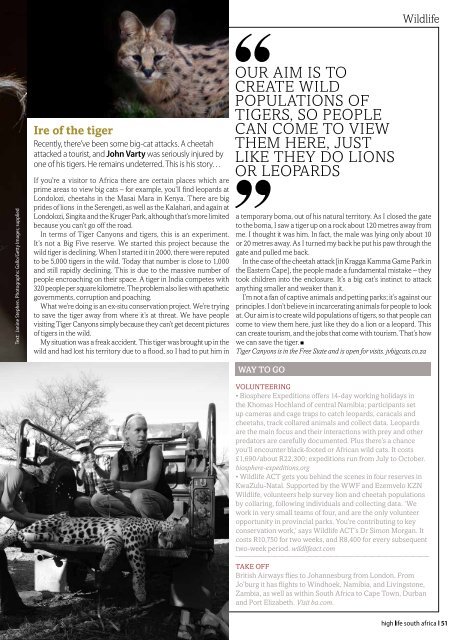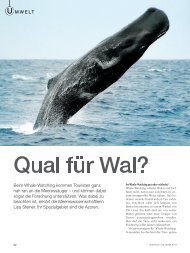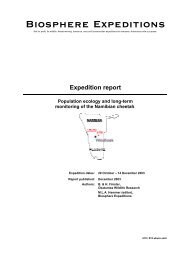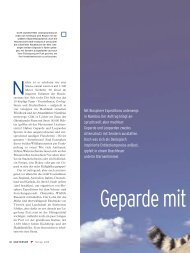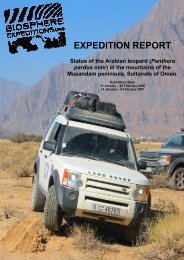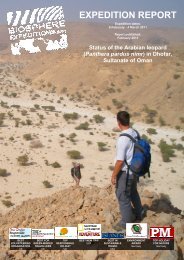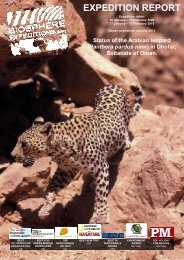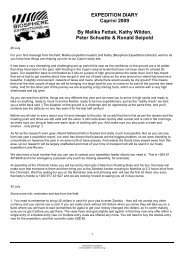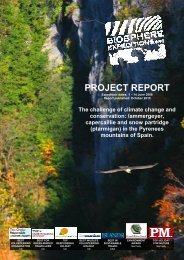View article 1.20 Mb - Biosphere Expeditions
View article 1.20 Mb - Biosphere Expeditions
View article 1.20 Mb - Biosphere Expeditions
Create successful ePaper yourself
Turn your PDF publications into a flip-book with our unique Google optimized e-Paper software.
Wildlife<br />
Text: Janine Stephen. Photographs: Gallo/Getty Images; supplied<br />
Ire of the tiger<br />
Recently, there’ve been some big-cat attacks. A cheetah<br />
attacked a tourist, and John Varty was seriously injured by<br />
one of his tigers. He remains undeterred. This is his story…<br />
If you’re a visitor to Africa there are certain places which are<br />
prime areas to view big cats – for example, you’ll find leopards at<br />
Londolozi, cheetahs in the Masai Mara in Kenya. There are big<br />
prides of lions in the Serengeti, as well as the Kalahari, and again at<br />
Londolozi, Singita and the Kruger Park, although that’s more limited<br />
because you can’t go off the road.<br />
In terms of Tiger Canyons and tigers, this is an experiment.<br />
It’s not a Big Five reserve. We started this project because the<br />
wild tiger is declining. When I started it in 2000, there were reputed<br />
to be 5,000 tigers in the wild. Today that number is close to 1,000<br />
and still rapidly declining. This is due to the massive number of<br />
people encroaching on their space. A tiger in India competes with<br />
320 people per square kilometre. The problem also lies with apathetic<br />
governments, corruption and poaching.<br />
What we’re doing is an ex-situ conservation project. We’re trying<br />
to save the tiger away from where it’s at threat. We have people<br />
visiting Tiger Canyons simply because they can’t get decent pictures<br />
of tigers in the wild.<br />
My situation was a freak accident. This tiger was brought up in the<br />
wild and had lost his territory due to a flood, so I had to put him in<br />
our aim is to<br />
create wild<br />
populations of<br />
tigers, so people<br />
can come to view<br />
them here, just<br />
like they do lions<br />
or leopards<br />
a temporary boma, out of his natural territory. As I closed the gate<br />
to the boma, I saw a tiger up on a rock about 120 metres away from<br />
me. I thought it was him. In fact, the male was lying only about 10<br />
or 20 metres away. As I turned my back he put his paw through the<br />
gate and pulled me back.<br />
In the case of the cheetah attack [in Kragga Kamma Game Park in<br />
the Eastern Cape], the people made a fundamental mistake – they<br />
took children into the enclosure. It’s a big cat’s instinct to attack<br />
anything smaller and weaker than it.<br />
I’m not a fan of captive animals and petting parks; it’s against our<br />
principles. I don’t believe in incarcerating animals for people to look<br />
at. Our aim is to create wild populations of tigers, so that people can<br />
come to view them here, just like they do a lion or a leopard. This<br />
can create tourism, and the jobs that come with tourism. That’s how<br />
we can save the tiger.<br />
Tiger Canyons is in the Free State and is open for visits. jvbigcats.co.za<br />
way to go<br />
volunteering<br />
• <strong>Biosphere</strong> <strong>Expeditions</strong> offers 14-day working holidays in<br />
the Khomas Hochland of central Namibia; participants set<br />
up cameras and cage traps to catch leopards, caracals and<br />
cheetahs, track collared animals and collect data. Leopards<br />
are the main focus and their interactions with prey and other<br />
predators are carefully documented. Plus there’s a chance<br />
you’ll encounter black-footed or African wild cats. It costs<br />
£1,690/about R22,300; expeditions run from July to October.<br />
biosphere-expeditions.org<br />
• Wildlife ACT gets you behind the scenes in four reserves in<br />
KwaZulu-Natal. Supported by the WWF and Ezemvelo KZN<br />
Wildlife, volunteers help survey lion and cheetah populations<br />
by collaring, following individuals and collecting data. ‘We<br />
work in very small teams of four, and are the only volunteer<br />
opportunity in provincial parks. You’re contributing to key<br />
conservation work,’ says Wildlife ACT’s Dr Simon Morgan. It<br />
costs R10,750 for two weeks, and R8,400 for every subsequent<br />
two-week period. wildlifeact.com<br />
TAKE OFF<br />
British Airways flies to Johannesburg from London. From<br />
Jo’burg it has flights to Windhoek, Namibia, and Livingstone,<br />
Zambia, as well as within South Africa to Cape Town, Durban<br />
and Port Elizabeth. Visit ba.com.<br />
high life south africa<br />
51


